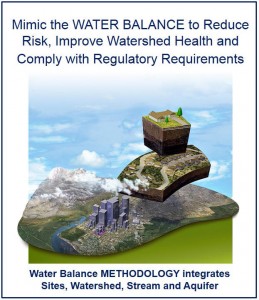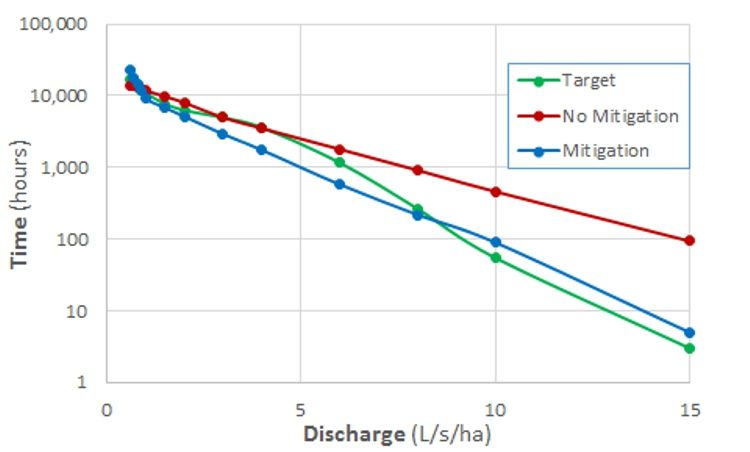Think and Act like a Watershed: the primacy of hydrology
Note to Reader:
In 1996, Richard Horner and Chris May (University of Washington) published their seminal research on the cumulative impacts of land use change on stream health. This established the primacy of hydrology. This recognition then led to development of the Water Balance Methodology, adopted by the Province of BC in 2002.
The methodology is evolving as science-based understanding grows. It is the foundation for an ecosystem-based approach to protection of hydrologic integrity, and hence stream system resilience. Recently implemented regulatory requirements in Washington State and California apply the same flow-duration science. Replicating the flow-duration pattern is the way to mimic the natural Water Balance.
Think and Act like a Watershed:
Water Balance Pathway to a Water-Resilient Future
(4th in a series connecting past and present research)
What Happens on the Land Matters!
The Water Balance of watersheds in urban areas is out of balance. A legacy of community and infrastructure design practices has failed to protect the water balance. Restoring hydrologic integrity, and thus the Water Balance, is the pathway to a water-resilient future.
Parallel Journeys in British Columbia, Washington State and California
“BC, Washington State and California are travelling along parallel pathways,” states Jim Dumont, Engineering Applications Authority, Partnership for Water Sustainability in BC.
 “Each region has its own terminology, such as hydromodification in California, yet the analytical methodologies have a common ‘flow-duration foundation’. This leads to the same outcome: mimic the Water Balance. A shared vision is to mimic streamflow and duration to limit stream erosion, prevent flooding and improve water quality.”
“Each region has its own terminology, such as hydromodification in California, yet the analytical methodologies have a common ‘flow-duration foundation’. This leads to the same outcome: mimic the Water Balance. A shared vision is to mimic streamflow and duration to limit stream erosion, prevent flooding and improve water quality.”
“The innovation in BC’s Water Balance Methodology is found in the integration and application of proven scientific and engineering principles. The methodology provides a logical and straightforward way to assess potential impacts resulting from urban development; and analytically demonstrate the effectiveness of the methods proposed for preventing and/or mitigating those impacts.”
“The Partnership for Water Sustainability is evolving the Water Balance Methodology as our understanding of HOW to restore hydrologic integrity grows. The methodology now synthesizes fundamentals of hydrology, flood protection, aquatic ecology, geomorphology and hydrogeology.”
“We integrated Flow-Duration Analysis in 2007. Washington State and California have gone a step further and mandated Flow-Duration Analysis as a regulatory requirement in 2012 and 2015, respectively. A commonality is that all three regions are addressing impacts to the stream.”
To Learn More:
 Download Primer on Water Balance Methodology for Protecting Watershed Health. The Primer storyline is structured in five parts:
Download Primer on Water Balance Methodology for Protecting Watershed Health. The Primer storyline is structured in five parts:
- Part A: Watershed-Based Approach to Rainwater Management
- Part B: Water Balance Methodology Explained
- Part C: Science Behind the Methodology
- Part D: How to Establish Targets
- Part E: References
For a synopsis of each part, download Table 1. Information is presented in a layered fashion to accommodate the interests of a continuum of audiences.
Establish Watershed Targets with Verifiable Calculations
“The flow-duration relationship is the cornerstone of the Water Balance Methodology,” continues Jim Dumont. “By maintaining flow-duration, stream erosion is not increased during wet weather and ‘environmental flows’ are sustained during dry weather. When homeowners slow, sink and spread rainwater runoff on their property, urban streams benefit.”
“Protection of streams and fish is an important public expectation in BC, creating a driving force altering our perceptions, aspirations, and treatment of the urban landscape. Water Balance Methodology objectives start with the stream and end with the stream, thereby providing a true measure of success for environmental protection.”
“Understanding how precipitation makes its way to the stream via three pathways, each with a different time scale, allows one to assess how a watershed and stream operate while analytically demonstrating impacts of development and the effectiveness of mitigation works. Managing watersheds as an integrated Water Balance system means: establish watershed targets with verifiable calculations. Then mitigation systems, such as rain gardens, can be optimized for both cost and function,” concludes Jim Dumont.
Coming this Fall…..
 In 2014, the Partnership for Water Sustainability released the Primer on the Water Balance Methodology for Protecting Stream Health. Later in 2016, the Partnership will release an updated Primer that elaborates on parallel journeys in Washington State, California and Australia.
In 2014, the Partnership for Water Sustainability released the Primer on the Water Balance Methodology for Protecting Stream Health. Later in 2016, the Partnership will release an updated Primer that elaborates on parallel journeys in Washington State, California and Australia.
The updated Primer will also incorporate a Peer Review / Perspective by Dr. Peter Coombes, former Chief Scientist, State of Victoria, Australia. “It is an exciting story of parallel endeavour – not exactly the same, but similar fundamental principles with opportunities to learn from each other on the differences,” foreshadows Dr. Coombes.



